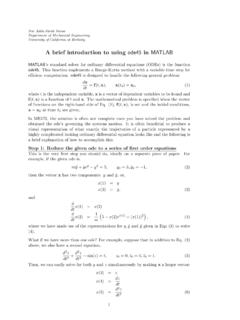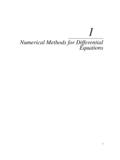Transcription of An interactive introduction to MATLAB
1 An interactive introduction to MATLAB . The University of Edinburgh, School of engineering 2010 2016. ABOUT THE COURSE. This course was developed in the School of engineering to provide appropriate material for teaching MATLAB1 in all engineering disciplines as well as to a wider audience. It is a self-study, self-paced course that emphasises responsible learning. Course material consists of this document used in conjunction with extensive online content. If you are a second-year engineering undergraduate student, there are also scheduled laboratory sessions where you can practice exercises and ask questions. Who should use this document? This document is targeted at those with no prior knowledge of MATLAB , and no previous programming experience. The aim, upon completion of the course, is to be competent using the most common features in MATLAB and be able to apply them to solve engineering problems.
2 What is in this document? This document forms part of a self-study course to help you get started with MATLAB . It should be used along with the support- ing online materials available at the or at the relevant module in the University's online learning envi- ronment LEARN. The main body of this document contains the fundamental topics for the course and there are also several more advanced topics given in appendices. How to use this document? This document contains different elements designed to make your learning experience as smooth as possible. To benefit the most from these elements you are encouraged to use the online PDF version of this document . One of the first things you'll notice is that this You can use the document contains many links: those in red indicate a link to online commenting tools in Adobe Reader to add material, and those in blue indicate a link to another section of this your own notes to this document.
3 PDF document A key part of this course are the screencasts, which are video screen captures ( ). In this docu- ment screencasts are indicated by a link in a blue box with a clap- perboard icon, like the example shown. Watching the Getting started screencasts and trying the examples for ( ). yourself will help you develop your skills in 1 MATLAB is a registered trademark of MathWorks MATLAB more quickly! iii Figure 1: A University of Edinburgh screencast Clicking on a link to a screencast will take you to the appropriate page on the course website where you will see the opening image to a University of Edinburgh screencast presented in the video player (Figure 1). Watching and learning from the screencasts are an essential part of the course and will help you develop your skills in MATLAB more quickly. You will also notice two other types of blue box environments in this document: one is for Hints and Tips (with a question mark icon), and the other contains exercises that you should complete (with an inkwell icon).
4 Hints and Tips Throughout this document you will also see Hints and Tips boxes like this one. Please read these as they contain useful hints! An example exercise Example exercise solutions Additionally there are grey box environments in this document. Like the example shown (Listing 1), these contain code listings that demonstrate actual MATLAB code. Line numbers are given to the left of the listings to make is simpler to refer to specific iv bits of code. Very often you will be required to copy and paste the listing into MATLAB and try running it for yourself. Listing 1: Example of a code listing 1 >> 5+5. 2 ans =. 3 10. Sources of help and further reading There are a huge number of textbooks published on the subject of MATLAB ! A user-friendly textbook that provides a good intro- duction to MATLAB is: Available from Amazon for c. 15. Gilat, A.
5 (2008). MATLAB : An introduction With Applica- tions. John Wiley & Sons, Inc., 3rd edition. There are a couple of further textbooks listed in the Bibliogra- phy section at the end of this document. However, throughout this course and beyond, the most important source of help is the documentation built-in to MATLAB . It is easily searchable, and because MATLAB contains many built-in functions it is worth checking out before starting to write your own code. MATLAB help documentation ( ). Accessed through the help menu in MATLAB , or online. MATLAB Central ( ). An open exchange for users, with code snippets, help forums and blogs. A great place to search for specific help! v Development of the course The development of this course was funded through The Edinburgh Fund Small Project Grant which is part of The University of Ed- inburgh Campaign ( ).
6 The material for this course was developed by Dr. Tina D ren, Dr. Antonis Giannopoulos, Dr. Guillermo Rein, Dr. John Thompson, and Dr. Craig Warren. Original screencasts created by Dr. Craig Warren. The update of original screencasts to the newest version of MATLAB 's User Interface ( MATLAB 2013a) was done by Joe Burchell. vi CONTENTS. 1 basic concepts 3. MATLAB in the School of engineering .. 3. The MATLAB environment .. 3. Basic calculations .. 4. Variables and arrays .. 6. Solving systems of linear equations .. 12. 2 plotting 19. Simple 2d plotting .. 19. Multiple plots in one Figure Window .. 22. Curve-fitting .. 23. 3d plotting using plot3 and surf .. 25. 3 scripts and functions 33. Script files .. 33. Functions .. 38. 4 decision making 43. Relational and logical operations .. 43. The if-else statement .. 46. 5 loops 55. for loops .. 55.
7 While loops .. 58. a advanced topic: the switch statement 65. b advanced topic: vectorisation 67. c additional exercises 69. Basic Concepts .. 69. Plotting .. 72. Scripts and Functions .. 80. Decision Making .. 85. Loops .. 86. bibliography 121. vii LIST OF SCREENCASTS. The MATLAB desktop .. 3. Exercise 1 Solutions .. 6. Variables and simple arrays .. 9. The dot operator .. 10. Indexing arrays .. 12. Exercise 2 Solutions Q 1 - 4 .. 17. Exercise 2 Solutions Q 5 - 8 .. 17. Creating a simple plot .. 21. Plotting experimental data .. 21. Exercise 3 Solutions .. 23. Basic Curve-fitting .. 24. Exercise 4 Solutions .. 28. Creating a simple script .. 35. Exercise 5 Solutions .. 37. Creating a function .. 41. Exercise 6 Solutions .. 42. The if-else statement .. 49. Exercise 7 Solutions Q1 and Q2 .. 53. Exercise 7 Solutions Q3 and Q4 .. 53. The for loop.
8 56. The while loop .. 59. Exercise 8 Solutions Q1 - Q3 .. 62. Exercise 8 Solutions Q4 - Q5 .. 62. viii LIST OF EXERCISES. Exercise 1: Basic calculations .. 6. Exercise 2: Variables and arrays .. 15. Exercise 3: Simple 2 d plotting .. 23. Exercise 4: 3 d plotting .. 27. Exercise 5: Scripts .. 36. Exercise 6: Functions .. 42. Exercise 7: Decision making .. 52. Exercise 8: Loops .. 62. ix L I S T O F TA B L E S. Table 1 Arithmetic operations .. 5. Table 2 Element-by-element arithmetic operations .. 10. Table 3 Line styles in plots .. 20. Table 4 Colours in plots .. 21. Table 5 Function definitions, filenames, input and output vari- ables .. 39. Table 6 Relational operators .. 43. Table 7 Logical operators .. 43. Table 8 Friction experiment results .. 71. Table 9 Results of a tension test on an aluminium specimen .. 73. Table 10 Coefficients for the cubic equation for the heat capacity of gases.
9 81. x A B O U T M AT L A B. what is MATLAB ? MATLAB is produced by MathWorks, and is one of a number of commercially available software packages for numerical computing and programming. MAT- LAB provides an interactive environment for algorithm development, data visualisation, data analysis, and numerical computation. MATLAB , which derives its name from MATrix LABoratory, excels at matrix operations and graphics. Its main competitors are Maple, Mathematica, and Mathcad, each with their own strengths and weaknesses. MATLAB student MATLAB is available in both commercial and academic versions with new version is available for around 55 + VAT. releases binannually e. g. R2016a (released around March 2016), and R2016b (released around September 2016). MATLAB itself is the core product and is augmented by additional toolboxes, many of which have to be purchased separately.
10 If you want to purchase a personal copy of MATLAB MathWorks offers a specially licensed student version with some of the most commonly used toolboxes for around 55 +VAT. However, the Univeristy has acquired a site license for MATLAB and students and staff can install MATLAB . on their computers for non-commercial use of MATLAB . More information on how to get access to MATLAB on your computer can be found at the Univeristy's Information Services website2. The accompanying online material, and the first version of screenshots and screencasts for this document were originally based on the R2009a release of MATLAB . As the MATLAB user interface was substantially redeveloped by Mathworks few years later the current version of the course has been re- designed to conform to this change and is now based on the new User interface introduced with MATLAB version R2013a running under Microsoft Windows.

